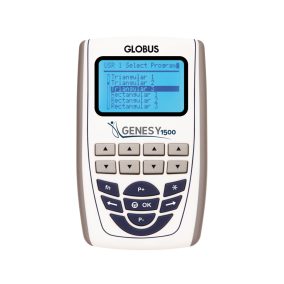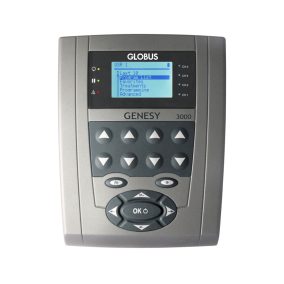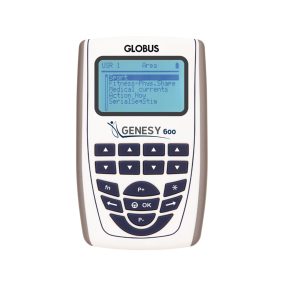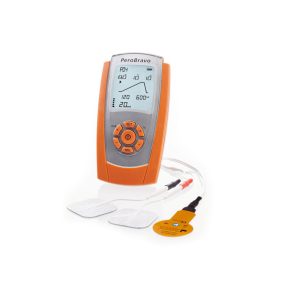Genesy 1500: multifunctional electrotherapy device. TENS /EMS /MCR-MENS /FES / denervated / Kotz / IF / iontophoresis. 4 channels, battery and power supply operation.
Price includes: device, 4 cables, 2 cables for microcurrent treatment, 4 pcs 50x50mm and 4 pcs 50x90mm TENS electrodes, battery charger, carrying bag
Genesy 3000: multifunctional electrotherapy device. TENS / EMS / MCR-MENS / FES / denervated / Kotz / IF / iontophoresis. 4 channels, battery and power supply operation.
Price includes: device, 4 cables, 2 cables for microcurrent treatment, 4 pcs 50x50mm and 4 pcs 50x90mm TENS electrodes, power adapter, built-in battery, carrying bag
Genesy 600: multifunctional electrotherapy device. TENS / EMS / MCR-MENS / FES / iontophoresis / denervated. 4 channels, battery-operated.
Price includes: device, 4 cables, 2 cables for microcurrent treatment, 4 pcs 50x50mm and 4 pcs 50x90mm TENS electrodes, battery charger, carrying bag
A selective stimulation device specialized for treating peripheral paralysis (e.g. peroneus or Bell's facial nerve). Optimized for treating muscles that have lost their motor nerve, i.e., denervated muscles. Provides both conventional and EMG-triggered stimulation.
Price includes: PeroBravo device, 4 electrodes (40x40mm), cable, foot switch, 2 rubber electrodes and sponge cover, 2 elastic fasteners, 4 AA batteries, battery charger, carrying bag
What is selective stimulation treatment?
Selective stimulation treatment is a type of electrotherapy. The term "selective stimulation" is used only in Hungary. In European medical jargon, the term denervated treatment is used instead.
This better expresses its purpose. Selective stimulation treatment is applied to so-called denervated muscles that have lost their motor nerves.
Such conditions include various forms of peripheral paralysis: peroneal paralysis, facial nerve paralysis, nerve injury following a herniated disc or spinal fracture, nerve damage during spinal surgery, etc.
Attention! Some therapists mistakenly use selective stimulation to treat central paralysis caused by conditions such as stroke or inflammation of the brain or spinal cord. However, selective stimulation treatment is not suitable for patients with stroke or central paralysis because it increases muscle stiffness (known professionally as increasing spasticity). The motor nerve of the muscle is healthy in central paralysis, meaning the problem lies at the brain's connection point, not at the periphery. Therefore, stroke paralysis should be treated not with selective stimulation but with "standard" biphasic square wave muscle stimulation at low frequency!
Selective stimulation is called so because it can affect denervated muscles. However, healthy innervated muscles do not need this; in fact, it is contraindicated!
During selective stimulation treatment, an electrical impulse with a current intensity in milliamps (mA) and long duration (100-900 milliseconds) is delivered through electrodes placed on the skin (these may be self-adhesive, metal, or rubber) to the treated muscle, causing it to contract. The impulse waveform can be triangular, trapezoidal, or square. By regulating frequency, intensity, and duration, the characteristics of the contraction can be defined: how much of the muscle bundle contracts, the speed, and frequency.
The treatment can be focused on a specific muscle or muscle group, so the effect is localized.
Normally, muscle contraction is initiated by an electrical signal from your brain. During electrostimulation, similar artificial impulses are given to the muscle.
In both cases, the contraction mechanism is identical, the same metabolic processes occur, and the muscle fatigues similarly.
Treatment of denervated (motor nerve lost) muscles
This is the main application of selective stimulation. The chances of recovery for denervated muscles increase significantly with daily selective stimulation treatment!
Those who do not receive regular stimulation treatment improve little or much more slowly. Stimulation provides a real chance for nerve regeneration and "re-growth."
It is important to understand that nerve pathways regenerate very slowly. Even in optimal cases with continuous stimulation, they grow at most 1 mm per day. For example, if your nerve was injured during spinal surgery, the nerve fiber length from the spine to the toes can be 70-80 cm, requiring a minimum of 700-800 days for complete regeneration! That equals about 3 years or more!
And you must persistently stimulate every day during this time! Without it, the muscle that lost its motor nerve wastes away and becomes a jelly-like mass in about two years, from which there is no return. Stimulation helps maintain the muscle tissue until the nerve grows back to the muscles.
A key capability of stimulation is "re-teaching" the neuromuscular (nerve-muscle) connection. According to some studies, the brain and the motor neuron running from the brain to the muscles require at least 10,000 repetitions to relearn how to perform a movement. Re-learning paralyzed muscles after paralysis can be significantly accelerated with stimulation.
It should be mentioned that not all muscle stimulators are suitable for stimulating peripheral nerve injury or, in professional terms, denervated (de-innervated) muscles. It is not advisable for a patient with paralysis to use a few-thousand-HUF device from Lidl or even more advanced inexpensive models! A more sophisticated device is necessary.
While muscles with healthy motor nerves respond to biphasic square wave stimulation, denervated muscles do not react to this. Instead, they contract in response to long-duration triangular or trapezoidal impulses!
Peripheral paralysis treatment typically has a "gradual curve." Treatment usually starts with triangular impulses and gradually shifts to trapezoidal and finally square impulses as the nerve regenerates.
Stimulation of muscles with healthy innervation
If the nerve fibers supplying the muscle are intact (even in stroke), selective stimulation is unnecessary. Biphasic square wave muscle stimulation is appropriate in such cases.
Another important difference is impulse duration. While selective stimulation for denervated muscles uses long impulses of 200-900 milliseconds (almost a second), healthy muscles require impulses that are thousandths of this duration (microseconds), i.e., much shorter impulses.














